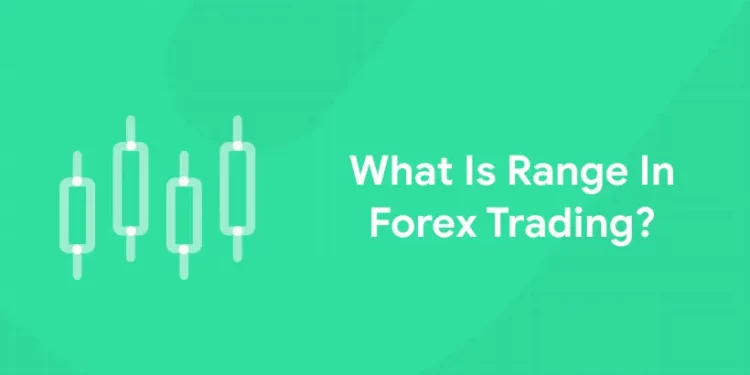Table of Contents
Only thirty per cent of the time do markets trend. Traders hoping to profit from large movements face an issue because of this reality. The markets usually trade in a range the rest of the time. But what does this mean? And What Is Range in Forex Trading?
What Is Range in Forex Trading: Introduction
Range trading is one of the simplest forex trading strategies. Although it works well when combined with other tactics like breakout trading and trend tracking, many people also utilize it alone with success.
A pricing chart’s range can be easily identified. Almost all financial charts include clear regions where the price appears to follow a predictable course. There is a vast array of variants available for these ranges. One reason why ranges are popular among traders is that they lessen uncertainty.
Want to learn forex trading? Join the Entri Forex trading online course today!
What Is Range in Forex Trading?
The range is the difference over a certain period between the low and high prices for an index or securities. It describes the variation between the highest and lowest prices that were exchanged over a given time frame, like a day, a month, or a year. The high and low points of a candlestick or bar represent the range on charts for a specific trading session.
What is Range Trading?
When a market trades steadily between two prices or levels for an established amount of time, it is said to be in a trading range. Range trading is visible on all time frames, from a short-term five-minute chart to long-term everyday and monthly charts, much like trend following, which applies to any time frame.
In contrast to trend following, range trading involves traders taking positions in both the long and short positions (at various times) based on where the price is in the range. Typically, trend-following traders will purchase dips during a rising trend and sell rallies during a falling one, following the general direction of the trend.
On the other hand, range trading enables a trader to execute both strategies, as a price is always moving between two distinct levels and not moving in either direction throughout that time frame.
Why is Range Trading Popular?
The popularity of range trading methods stems from the fact that markets only trend, or move in one significant direction, a small percentage of the time. Since most activity occurs in a range, the ability to identify opportunities in any sideways price action is crucial.
The majority of traders who follow short-term trading strategies, such as scalping and day trading, employ range trading. This is due to its emphasis on making rapid trades in the short-term movement between two levels as opposed to a long-term trend. It’s also a popular tactic used by forex traders, who try to profit from the quick and tiny fluctuations in currency values.
Are you searching for the best forex trading mentors? Register for the Entri Forex course today!
What is A Trading Range Breakout?
When momentum increases and the market breaks through such levels of support and resistance, a trading range breakout takes place. Although trend traders usually use breakouts, it is crucial to know where prices will break out from support or resistance levels even in a rangebound market.
This offers a clear exit point for any open trades, in addition to allowing traders to use trend-following strategies to profit from a fresh, strong trend. Setting a stop loss at or right after a level of support or resistance might lessen losses if a breakthrough happens.
Range Types
Ranges arise when the price is restricted between a support and resistance area. Entering (or leaving) close to the range boundaries is the fundamental method of trading ranges. This entails purchasing at the bottom of the range and selling at the top of the range. Price increases are resisted at the top of the range and price declines are supported at the bottom.
Let us learn more about various types of ranges before looking for accurate strategies to trade during them.
Rectangular Range
A rectangular range is characterized by lateral price movement between roughly horizontal top resistance and lower support. While these ranges are more prevalent than channels or continuation ranges, they are nonetheless commonplace at all time scales. Horizontal ranges on the chart are simple to identify, both visually and through the use of indicators. Usually, the horizontal range displays:
- Clearly defined zones of support and resistance at both the top and bottom
- Flattening of the moving average lines
- Peaks and troughs located inside a horizontal band
Price Channels (Diagonal Ranges)
Another popular forex chart pattern is the price channel. These are just diagonal ranges. The price moves up or down within a sloping trend channel in this type of range. The channel can be rectangular. However, it can be both narrowing and broadening.
Channels can run for months or even years at a time. These are trends, of course, but the majority of opportunities for short-term trading will occur within the ranges that emerge within the trend. Channels can therefore be traded using either a breakout or trend-following method. These are typically continuation patterns when short-duration channels arise in opposition to the primary trend. These consist of pennants, flags, and wedges.
Breakouts typically occur in the other direction with channel ranges, particularly the shorter-duration ones. The most likely break in an upward-sloping range is to the downside. The most likely break in a range that slopes downward is on the upside. Although it is by no means a firm guarantee, this is a helpful generalization in technical analysis.
False “Channel Breakouts”
News releases are one of the many factors that might cause false breakdowns. These can occasionally be the outcome of program trades in which automatic systems join as soon as a data release is made. However, the move “fades” as the market’s consensus opinion re-establishes itself because the market has frequently already taken in the news before it was released. After that, the cost returns to the initial track. Some traders would rather trade in one direction than the other, depending on the currency pair and the range slope.
Continuations Ranges: Flags, Pennants, Wedges
Chart patterns that arise within trends are called continuation ranges. These consist of triangles, pennants, flags, and wedges. These ranges typically indicate a correction away from the prevailing trend. Bearish or bullish signals can be seen in them.
These patterns can show themselves in almost any period. Depending on your trading time horizon, you can trade them as breakouts or as ranges on their own. Many traders prefer to trade these patterns as breakouts rather than ranges since they might result in big bullish or bearish breakouts when the current trend resumes.
Irregular Ranges
In the majority of ranges, the pattern is not immediately apparent. These formations involve price movements centred around a pivot line, around which support and resistance zones form. These ranges can be marked out and the support and resistance areas located using tools like trend line analyzers and moving averages.
Instead of trading these kinds of ranges at the extremes, some traders want to trade them towards the centre pivot axis. By doing this, they want to swap out price extremes in the hopes that it will eventually return to its mean or the central pivot axis. By using this method, you aim to profit from price swings as the price approaches the range’s middle axis while maintaining a modest profit target.
As previously indicated, there is always a potential for a breakout (or partial move that hits a stop loss) as the price hits the range wall. As a result, trading along the range’s edges requires the trader to rely on the price shifting in their favour. Trading the central area reduces the dangers associated with turns near the range’s margins.
Ranges and Volatility
Since risk is equal to price volatility, a security’s trading range can be used as an accurate measure of risk. Securities with less price volatility are more appealing to a conservative investor than those that are prone to large price swings.
Instead of investing in more cyclical or high-beta sectors like financials, technology, and commodities, this type of investor could favour more stable industries like utilities, healthcare, and telecommunications. Generally speaking, high-beta sectors tend to have larger ranges than low-beta sectors.
Range Support and Resistance
The trading range of securities can be used to show levels of support and resistance. If the bottom of a stock’s range has been around $10 on multiple occasions over many months or years, then the $10 region would be regarded as an area of strong support. If the price breaks below that level, traders see it as a bearish indicator, particularly if there is significant volume.
On the other hand, a breakout above a price that has repeatedly represented the range’s top is regarded as a breach of resistance and sends out a bullish signal.
Get the best forex trading lessons from experts! join Entri Forex trading online course today!
Trading Approaches for Each Range
The price changes within a range typically veer toward a central line. Reaching your profit target is more likely if you position your entry and profit target away from the extremities. Additionally, it raises the quantity of tradeable opportunities available to you. However, it will lower your possible gains on each trade, which is a drawback. The basic technique for trading a range is given below.
Await the price reversal at the wall’s edge or around two-thirds of the way from it. Usually, consolidation occurs in the vicinity of these levels before a reversal.
When moving toward the middle of the range and away from the boundary, confirm the move with two or more candles.
Set the take profit (TP) level no higher than two-thirds of the range’s breadth because the price frequently turns before the support or resistance. To accommodate failed breaks, set the stop loss sufficiently outside the range limit. In addition to supporting and resistance zones (as well as those at longer timescales), the ATR signal helps determine a stop loss.
Setups that appear “too obvious” should be avoided. If something appears too good to be true, it usually is. Likewise, if the range appears certain, a breakout could occur at any time.
How to Use Range?
The range can be utilized to measure the possible risk of a trade, just like any other volatility indicator. There is typically more risk involved in trading a market with wide fluctuations in price. The degree of resistance and support can also be determined using it.
The upper and lower bounds of a range might be interpreted as significant places of support and resistance if the market has been trading inside it for an extended length of time.
How to Calculate Range?
Simply subtract the lowest price point from the highest price point that was attained during the time under analysis to get the range.
Range Trading: Important Terms
Some important terms that are essential for understanding the concepts and methods in range trading are given below.
Pivot Points
Pivot points are indications that are derived from the average intraday high and low as well as the previous day’s closing price through mathematical computations. The next trading day, these lines are then drawn out to project levels of support and resistance.
Although pivot points can be customized, your trading software will typically include the following lines automatically:
- P is the line of reference.
- S lines, which display varying degrees of support
- R lines, which display varying degrees of resistance
The theory behind these lines is that they can tell traders where potential exhaustion points may still lie. Therefore, they can locate the best entry and exit sites by using the lines.
Get the best learning materials to learn forex trading! Get the best mentors and live support!
Relative strength index (RSI)
Relative strength index (RSI) and pivot points are frequently used by range traders to confirm overbought and oversold signals or levels at which the market is expected to turn.
The ratio of a market’s average gains on days it finished higher to its average losses on days it closed lower is what the RSI calculates. Next, this is shown as a number between 0 and 100.
Range traders may take an RSI reading below 20 and rising as a possible indicator that a level of support has been reached and that the market will start to move higher. However, if the RSI crosses 80 and then begins to decline, it may indicate that a resistance level has been identified and the market is about to move lower.
Average Directional Index (ADX)
A chart’s average directional index (ADX) is represented by a single line. It determines the strength of the present trend in a market by calculating the price action of late.
Range traders wishing to determine if a new trend is strong enough to break out from a recognized support or resistance level may find this to be helpful. The strength of the present trend increases with the ADX line’s height. A strong trend is defined as anything above 25, whereas a weak or nonexistent trend is defined as anything below 20.
On-Balance Volume
Range trading relies heavily on volume, which indicates to traders whether or not a particular movement has any strength. Thus, signals that support the validation of activity are quite helpful. Volume is supposed to rise in the direction of a trend if one is forming because volume is said to precede price.
When the price approaches a support or resistance level, range traders would want to see a decrease in volume before it bounces off in the opposite direction. It is more likely that the level will be broken and a breakout will take place if the indicator suggests that volume is still rising at a support or resistance line. The range is likely to extend if the price levels are broken with little volume, indicating that this is a fake breakout.
What Is Range in Forex Trading: Conclusion
Even though various players may use different methods, the number of active participants at any given time might determine the effectiveness of range trading. A trading range looks for specific signs of volatility and risk. Inexperienced or weaker traders shouldn’t engage in this kind of trading. Trading in more stable low-beta industries, like healthcare, would be a good place to start.
Frequently Asked Questions
What Drawbacks Does Range Trading Have?
Every trading strategy involves some level of risk, and that risk rises when market patterns shift from contraction to expansion and vice versa. A trader’s ability to recognize a market’s trend while trading is crucial to the success of range trading.
How Do You Implement a Range-Bound Trading Strategy?
As the name suggests, range trading involves an investor buying and selling within a range of values, one representing the current price of a stock and the other representing a price they predict it will climb to. Within certain price ranges, the investor trades. The strategy can be applied several times over a certain length of time until the stock price reaches the investor’s perceived ceiling and it becomes appropriate to exit the investment.
What is the definition of a high-beta index?
Stocks with significant volatility make up a high-beta index. Although they usually carry a higher risk, investors who are prepared to take a small chance in exchange for higher returns may find them alluring.










